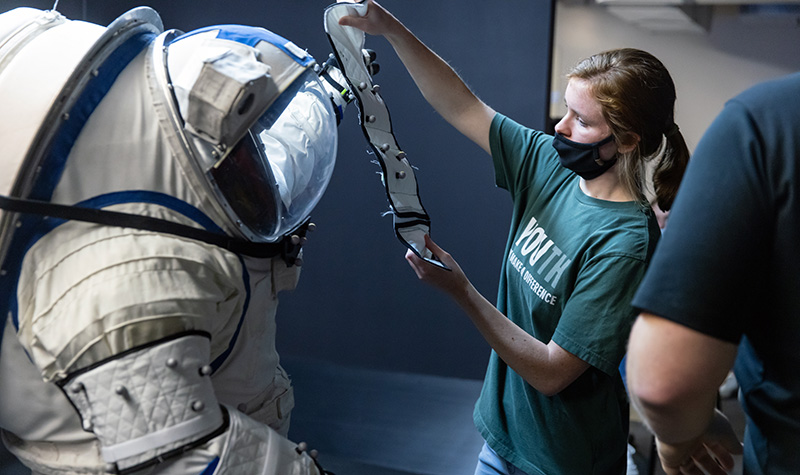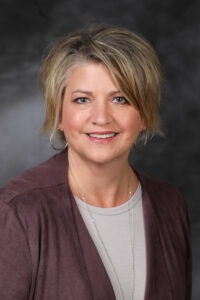Bridge Fellowship connects students to STEM research
UND kinesiology major helps NASA determine if spacesuit has the Right Stuff for top astronaut performance
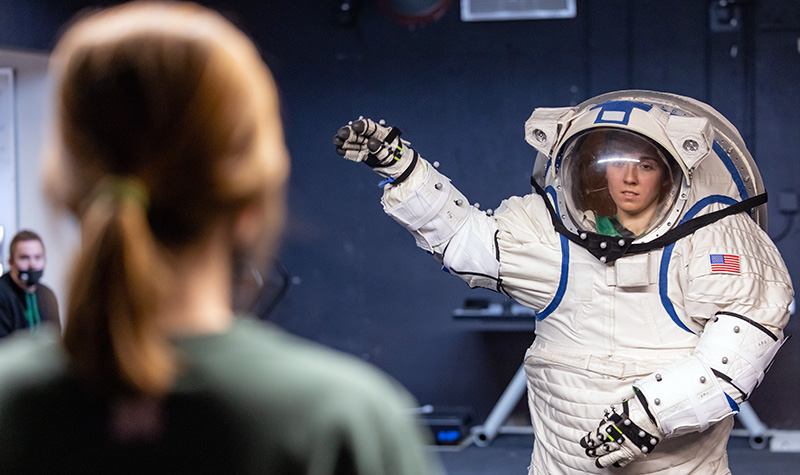
That’s the Big Dipper. That’s the Little Dipper. And not so long ago, that’s about as deep as Lake Region State College graduate Liz Deckert wanted to dip into space science.
But that was before the kinesiology major and future chiropractor transferred this fall to the University of North Dakota, where she landed a NASA-funded Bridge Fellowship through the North Dakota Space Grant Consortium.
Now, just a few months into her junior year at UND, the space rookie from Devils Lake is doing cutting-edge research for NASA’s next-generation spacesuit.
More specifically, she’s testing upper mobility acceleration and range of motion for a spacesuit developed by Final Frontier Design, a company that already has three spacesuit components — boot, hip and waist joints — booked for the next trip to the moon. And though experts have questioned whether the mission will be ready for a 2025 launch, when it eventually does blast off, Artemis 3 is expected to be the first “crewed” lunar landing in more than half a century. The last one was Apollo 17 in 1972.
Historically speaking, that’s a pretty big deal. And for 19-year-old Deckert, it’s one giant leap — no matter where her research lands. After all, not everyone can say they played a part in developing the spacesuit that astronauts could wear for the next 20 years.
“This is not something I ever would have imagined myself doing, especially because I know nothing about space,” Deckert said with a laugh. “It’s so cool to be part of this and so humbling at the same time to be surrounded by all these people who know so much.”
One of those people is fellowship mentor Jesse Rhoades, an associate professor of kinesiology at UND’s College of Education & Human Development, and also director of the University’s BiPed Laboratory.
Rhoades has partnered with UND Space Studies for previous research, but said this is his first time as a faculty advocate for the Fellowship Bridge Program. The flexible entry-level research program is designed to introduce students who have earned an undergraduate degree and are starting a new program to collaborative NASA-relevant research or education projects in science, technology, engineering or mathematics.
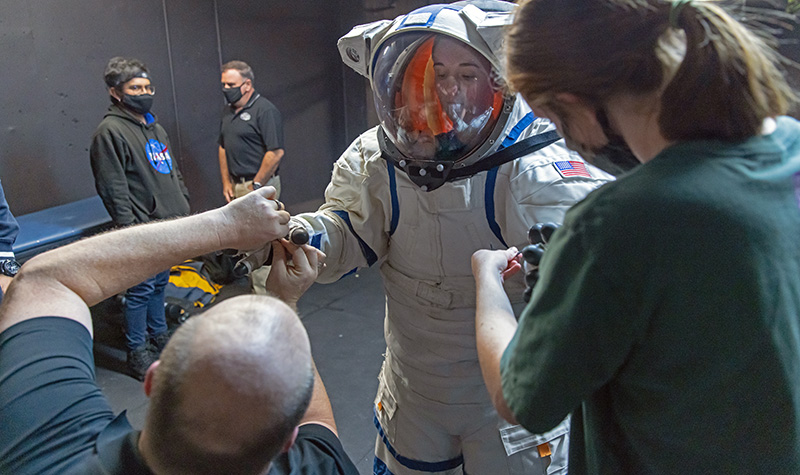
Combining kinesiology, space
Recently, UND Today caught up with both Rhoades and Deckert in the depths of the Bi-Ped Laboratory, where most of their research will take place over the next several months.
Situated at the end of a long, nondescript hallway in the basement of the UND Clinical Education Center, the cavernous laboratory’s rather simple surrounds belie the magnitude of the important research and discovery going on there.
“This is really where the magic happens,” Rhoades said as he shuffled an old, olive-green office chair to make room next to a hodgepodge of desks supporting random equipment and several supersized computer screens. A box filled with odd-sized balls was the only other thing that stood out in the bare-bones room.
Next door was a second room, just as spacious and just as sparse, but floor-to-ceiling black — with 18 cameras mounted high, low and in between. A lonely treadmill stood on one end, and in the center of the space was what appeared to be a large scaffold bridge.
That’s the spot for camera close-ups, Rhoades explained. And it’s the same spot where Deckert has spent dozens of hours over the past several weeks painstakingly attaching Velcro plates to the shoulders, arms, hands, hips and chests of her curious volunteers. Once she has all the plates in place, just as a chiropractor might instruct her patient to twist an arm or wrist, Deckert directs her volunteers in intricate detail how to complete a series of precision arm-sweeping motions.
“If you think about it, there really are a lot of clinical or chiropractic connections,” she said. “This research is teaching me to think very differently, and I find myself trying harder and harder just to think outside the box.”
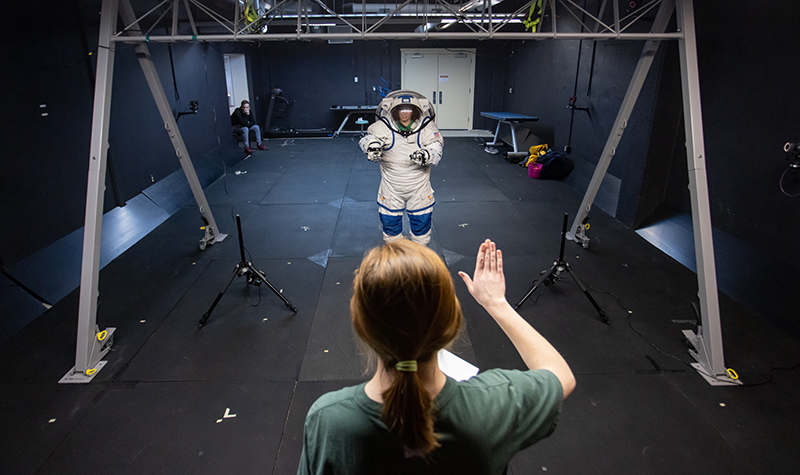
Just like the movies
While her volunteer performs the moves and the cameras roll, reflective sensor balls atop the plates extract the raw research data by bouncing infrared light back to the cameras, which later can triangulate marker positions in 3D space.
It sounds complicated, but Rhoades explains it away, saying it’s the very same motion-capture technology used in the movies.
“The only difference between us and a movie studio is they have more expensive cameras and way more of them,” he said with a laugh.
Well, at least one other thing is different. Rhoades and Deckert aren’t producing blockbuster “Avatar” movies. Rather, they’re creating groundbreaking science. That’s because once they have a clean marker set, they can run it through sophisticated software to extrapolate all kinds of kinetic information.
“Essentially, what we’re doing and what NASA is paying us to test is if this spacesuit is good,” Rhoades said. “They want to know how it’s going to operate if they put an astronaut in it … will it perform up to their standards. Say there’s an emergency, will they be able to reach far enough and fast enough to hit a certain button in the cockpit? Can they do that in this spacesuit?”
That’s a big ask, but that’s exactly the kind of answers the high-tech research is expected to deliver. Only about 10 other studies have looked at what’s referred to as this particular “work envelope” in the past 20 years, Rhoades said. The eleventh — UND’s study — will determine if the spacesuit presents any limitations to the astronaut’s dexterity or range of motion in that upper body.
Rhoades summed it up another way: “Your spacesuit is basically a tiny, self-contained spaceship, and you’re the engine or motor that makes it go. You’ve got to make sure it can move, right? Otherwise, you’re going to have big problems.”
So far, Rhoades and Deckert are roughly a month into the project that’s expected to last through April. And at this stage, they’re still “fine-tuning their instruments.”
But soon, they’ll be able to put volunteers in a spacesuit developed by Pablo de Leon, professor and chair of UND’s Department of Space Studies. And after that, they’ll run tests again with the actual spacesuit from Final Frontier Design.
No matter the final results, Rhoades says the Bridge Fellowship and the research it supports is a win-win for UND and its students.
“The experiential learning can’t be beat, and there are endless possibilities for collaboration and crossover research on campus,” he said. “Engineering, aerospace, space studies, geology, physiology … it’s just one of those things where the connections are there. You just have to explore them.”
